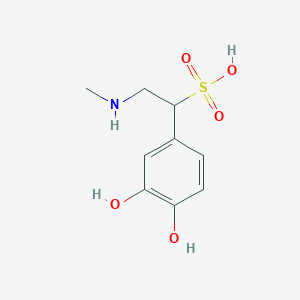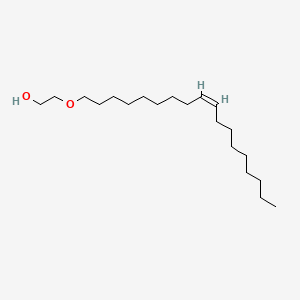
1-Azido-3-iodopropane
- Cliquez sur DEMANDE RAPIDE pour recevoir un devis de notre équipe d'experts.
- Avec des produits de qualité à un prix COMPÉTITIF, vous pouvez vous concentrer davantage sur votre recherche.
Vue d'ensemble
Description
1-Azido-3-iodopropane is a useful research compound. Its molecular formula is C3H6IN3 and its molecular weight is 211.00 g/mol. The purity is usually 95%.
BenchChem offers high-quality this compound suitable for many research applications. Different packaging options are available to accommodate customers' requirements. Please inquire for more information about this compound including the price, delivery time, and more detailed information at [email protected].
Applications De Recherche Scientifique
Applications in Click Chemistry
Click chemistry refers to a set of powerful reactions that allow for the rapid and efficient formation of covalent bonds. 1-Azido-3-iodopropane is particularly useful in:
- Copper-Catalyzed Azide-Alkyne Cycloaddition (CuAAC) : This reaction involves the reaction of azides with terminal alkynes to form 1,2,3-triazoles. The use of this compound facilitates the synthesis of various triazole derivatives, which have applications ranging from drug development to materials science .
| Reaction Type | Description | Applications |
|---|---|---|
| CuAAC | Reaction between azides and alkynes | Drug synthesis, materials science |
| Strain-Promoted Azide-Alkyne Cycloaddition (SPAAC) | Copper-free alternative for biological applications | Bioconjugation in living systems |
Bioconjugation and Protein Labeling
This compound is employed for bioconjugation processes, particularly in labeling proteins with fluorescent tags. For instance, bovine serum albumin (BSA) can be modified with azide groups using this compound, allowing for subsequent labeling with fluorophores through click chemistry . This method is advantageous due to its specificity and efficiency.
Case Study: Fluorescent Labeling of Proteins
A study demonstrated the use of this compound to label BSA with fluorescent dyes. The process involved:
- Treating BSA with this compound in a TRIS buffer.
- Irradiating the mixture to facilitate the reaction.
- Analyzing the resulting fluorescently labeled protein using spectroscopic methods.
This technique highlights the potential for real-time imaging and tracking of proteins in biological systems .
Pharmaceutical Applications
The compound has been explored for its potential in developing new pharmaceuticals. Its ability to form stable triazole linkages makes it a candidate for synthesizing bioactive compounds.
Case Study: Antifungal Activity
Research has indicated that derivatives synthesized from this compound exhibit antifungal properties. A series of compounds were prepared through click chemistry involving this azide, leading to promising results against various fungal strains .
| Compound | Activity | Target Organisms |
|---|---|---|
| Triazole Derivative A | Moderate | Candida albicans |
| Triazole Derivative B | High | Aspergillus niger |
Material Science Applications
In material science, this compound is utilized for modifying surfaces and creating functional materials. Its reactivity allows for the incorporation of azide functionalities into polymers, which can then undergo click reactions to create crosslinked networks or functionalized surfaces.
Case Study: Surface Functionalization
A study demonstrated the functionalization of polymer surfaces with azide groups using this compound, followed by subsequent reactions with alkyne-functionalized compounds. This approach enabled the creation of bioactive surfaces suitable for tissue engineering applications .
Propriétés
Formule moléculaire |
C3H6IN3 |
|---|---|
Poids moléculaire |
211.00 g/mol |
Nom IUPAC |
1-azido-3-iodopropane |
InChI |
InChI=1S/C3H6IN3/c4-2-1-3-6-7-5/h1-3H2 |
Clé InChI |
GTBCENNLSAZFSM-UHFFFAOYSA-N |
SMILES canonique |
C(CN=[N+]=[N-])CI |
Origine du produit |
United States |
Avertissement et informations sur les produits de recherche in vitro
Veuillez noter que tous les articles et informations sur les produits présentés sur BenchChem sont destinés uniquement à des fins informatives. Les produits disponibles à l'achat sur BenchChem sont spécifiquement conçus pour des études in vitro, qui sont réalisées en dehors des organismes vivants. Les études in vitro, dérivées du terme latin "in verre", impliquent des expériences réalisées dans des environnements de laboratoire contrôlés à l'aide de cellules ou de tissus. Il est important de noter que ces produits ne sont pas classés comme médicaments et n'ont pas reçu l'approbation de la FDA pour la prévention, le traitement ou la guérison de toute condition médicale, affection ou maladie. Nous devons souligner que toute forme d'introduction corporelle de ces produits chez les humains ou les animaux est strictement interdite par la loi. Il est essentiel de respecter ces directives pour assurer la conformité aux normes légales et éthiques en matière de recherche et d'expérimentation.















